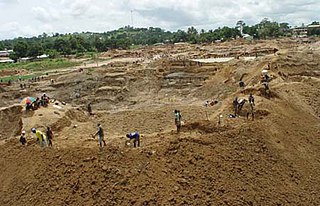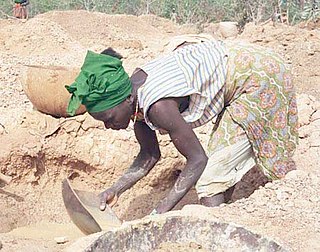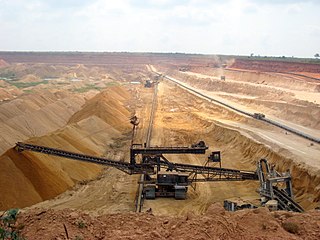
The economy of Sierra Leone is $4.082 billion by gross domestic product as of 2018. Since the end of the Sierra Leone Civil War in 2002, the economy is gradually recovering with a gross domestic product growth rate between 4 and 7%. In 2008 it in PPP ranked between 147th by World Bank, and 153rd by CIA, largest in the world.

Blood diamonds are diamonds mined in a war zone and sold to finance an insurgency, an invading army's war efforts, terrorism, or a warlord's activity. The term is used to highlight the negative consequences of the diamond trade in certain areas, or to label an individual diamond as having come from such an area. Diamonds mined during the 20th–21st century civil wars in Angola, Ivory Coast, Sierra Leone, Liberia, Guinea, and Guinea-Bissau have been given the label. The term conflict resource refers to analogous situations involving other natural resources. Blood diamonds can also be smuggled by organized crime syndicates so that they could be sold on the black market.
The Sierra Leone Civil War (1991–2002), or the Sierra Leonean Civil War, was a civil war in Sierra Leone that began on 23 March 1991 when the Revolutionary United Front (RUF), with support from the special forces of Liberian dictator Charles Taylor's National Patriotic Front of Liberia (NPFL), intervened in Sierra Leone in an attempt to overthrow the Joseph Momoh government. The resulting civil war lasted almost 11 years, and had over 50,000, up to 70,000, casualties in total; an estimated 2.5 million people were displaced during the conflict.

Global Witness is an international NGO established in 1993 that works to break the links between natural resource exploitation, conflict, poverty, corruption, and human rights abuses worldwide. The organisation has offices in London and Washington, D.C.

Mining in Western Australia, together with the petroleum industry in the state, accounted for 94% of the State's and 46% of Australia's income from total merchandise exports in 2019–20. The state of Western Australia hosted 123 predominantly higher value and export-oriented mining projects and hundreds of smaller quarries and mines. The principal projects produced more than 99 per cent of the industry's total sales value.
Titanium mining in Africa has been beset by environmental problems due to the polluting nature of processing rutile, a principal titanium ore. Titanium production in Africa includes the following principal countries and companies.
Jamil Sahid Mohamed Khalil was a Sierra Leonean-Lebanese businessman, diamonds and commodities trader. He attained prominence in the diamond industry across Africa and Antwerp and became an influential figure in the politics of Sierra Leone through his close association with President Siaka Stevens. Jamil also came to dominate other business sectors including fisheries, tourism construction and aviation.

The Mining industry of Ghana accounts for 5% of the country's GDP and minerals make up 37% of total exports. Gold contributes over 90% of the total mineral exports. Thus, the main focus of Ghana's mining and minerals development industry remains focused on gold. Ghana is Africa's largest gold producer, producing 80.5 t in 2008. Ghana is also a major producer of bauxite, manganese and diamonds. Ghana has 20 large-scale mining companies producing gold, diamonds, bauxite and manganese; over 300 registered small scale mining groups; and 90 mine support service companies. Other mineral commodities produced in the country are natural gas, petroleum, salt, and silver.
Despite being a mineral rich country, Cameroon has only recently begun to investigate mining on an industrial scale. Strong metal and industrial mineral prices since 2003 have encouraged companies to develop mines here. The terrain mainly consists of granite-rich ground with areas of ultramafic rocks that are sources of cobalt and nickel. There are also deposits of bauxite, gold, iron ore, nepheline syenite, and rutile. Alluvial gold is mainly mined by artisanal miners.

The mineral industry is one of the main sectors of the Armenian economy and in 2017 accounted for 30.1% of its exports.
The second-largest mineral industry in the world is the mineral industry of Africa, which implies large quantities of resources due to Africa being the second largest continent, with 30.37 million square kilometres of land.With a population of 1.4 billion living there, mineral exploration and production constitute significant parts of their economies for many African countries and remain keys to economic growth. Africa is richly endowed with mineral reserves and ranks first in quantity of world reserves for bauxite, cobalt, industrial diamond, phosphate rock, platinum-group metals (PGM), vermiculite, and zirconium.
Africa has a large quantity of natural resources, including diamonds, sugar, salt, gold, iron, cobalt, uranium, copper, bauxite, silver, petroleum, and cocoa beans, but also tropical timber and tropical fruit.

The Ministry of Mineral Resources (MMR) Sierra Leone is located on the 5th Floor Youyi Building, Brookfields, Freetown, Sierra Leone. Further to this the MMR Geological Surveys Department can be found at the New England estate, also in Freetown. The Ministry supports a network of regional offices in Makeni, Bo, Kenema and Kono, each headed by a Government Mines Engineer.
Jean-Raymond Boulle, COR is a Monaco-based Mauritian businessman, the founder of four publicly traded companies with deposits of nickel, cobalt, copper, zinc, titanium and diamonds.

The mining industry of Guinea was developed during colonial rule. The minerals extracted consisted of iron, gold, diamond, and bauxite. Guinea ranks first in the world in bauxite reserves and 6th in the extraction of high-grade bauxite, the aluminium ore. The mining industry and exports of mining products accounted for 17% of Guinea's gross domestic product (GDP) in 2010. Mining accounts for over 50% of its exports. The country accounts for 94% of Africa's mining production of bauxite. The large mineral reserve, which has mostly remained untapped, is of immense interest for international firms.

The mining industry of Togo is centred mainly around the extraction of phosphate, ranking it 19th in world production. Other minerals extracted are diamond, gold, and limestone. More minerals identified but yet to be brought into production mode are manganese, bauxite, gypsum, iron ore, marble, rutile, and zinc. The mineral sector contributes 2.8% to the country's gross domestic product (GDP).

The mining industry of Liberia has witnessed a revival after the civil war which ended in 2003. Gold, diamonds, and iron ore form the core minerals of the mining sector with a new Mineral Development Policy and Mining Code being put in place to attract foreign investments. In 2013, the mineral sector accounted for 11% of GDP in the country and the World Bank projected a further increase in the sector by 2017.

The mining industry of Senegal is mainly centred on the production of phosphates and industrial limestone. Senegal is one of the leading producers of phosphates in the world, accounting for about 6% of exports in 2006, and deposits are of a particularly high quality. In the coastal region of the country, titanium-bearing minerals have been found and the reserve is estimated at 10 million tons. The mineral sector's exports accounts for 20% of total exports of the country and constitutes 20% of the GDP.
Sierra Rutile Limited is a mining company with headquarters based in Freetown, Sierra Leone. The company currently has operating mines for Rutile, ilmenite, zircon, and titanium dioxide minerals in South and Northwest Sierra Leone, specifically in the Moyamba and Bonthe Districts. Australian-based Iluka Resources Limited acquired the company in December 2016 and subsequently installed new and currently acting CEO Rob Hattingh.

Corruption is endemic in Sierra Leone. Sierra Leone is widely considered to be one of the most politically and economically corrupt nations in the world and international rankings reflect this. Transparency International's 2023 Corruption Perceptions Index scored Sierra Leone at 35 on a scale from 0 to 100. When ranked by score, Sierra Leone ranked 108th among the 180 countries in the Index, where the country ranked first is perceived to have the most honest public sector. For comparison with worldwide scores, the best score was 90, the average score was 43, and the worst score was 11. For comparison with regional scores, the average score among sub-Saharan African countries was 33. The highest score in sub-Saharan Africa was 71 and the lowest score was 11. The 2018 Global Competitiveness Report ranked Sierra Leone 109th out of 140 countries for Incidence of Corruption, with country 140 having the highest incidence of corruption. Corruption is prevalent in many aspects of society in Sierra Leone, especially in the aftermath of the Sierra Leone Civil War. The illicit trade in conflict diamonds funded the rebel Revolutionary United Front (RUF) forces during the civil war, leading to fighting between the Sierra Leone Army and the RUF for control of the diamond mines. Widespread corruption in the health care sector has limited access to medical care, with health care workers often dependent on receiving bribes to supplement their low pay.

















